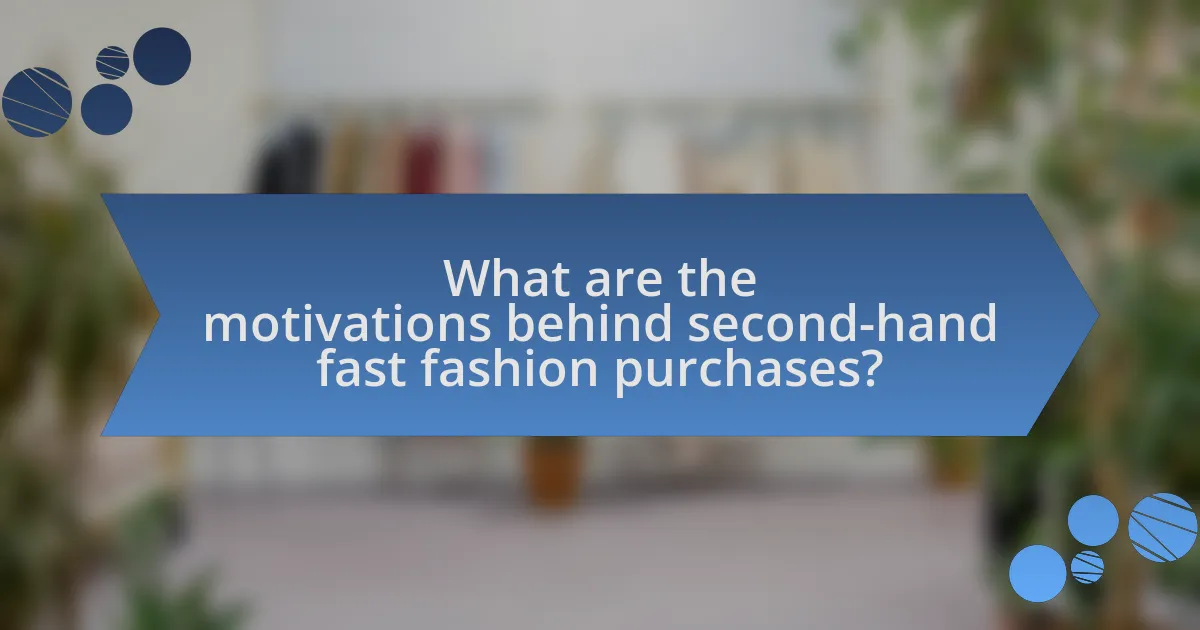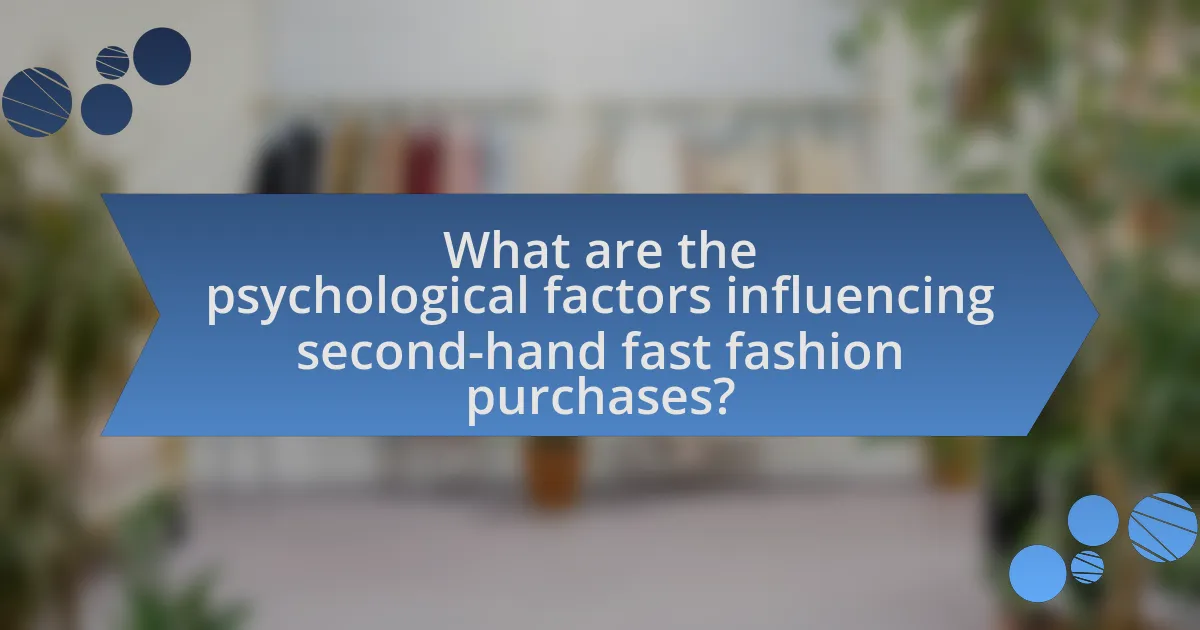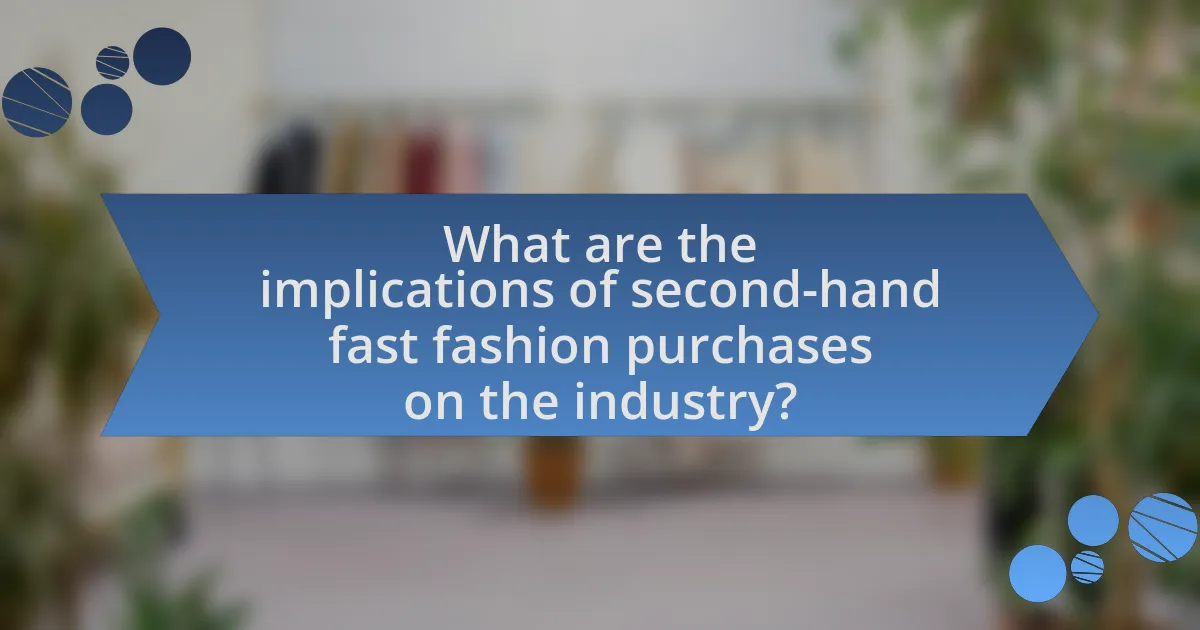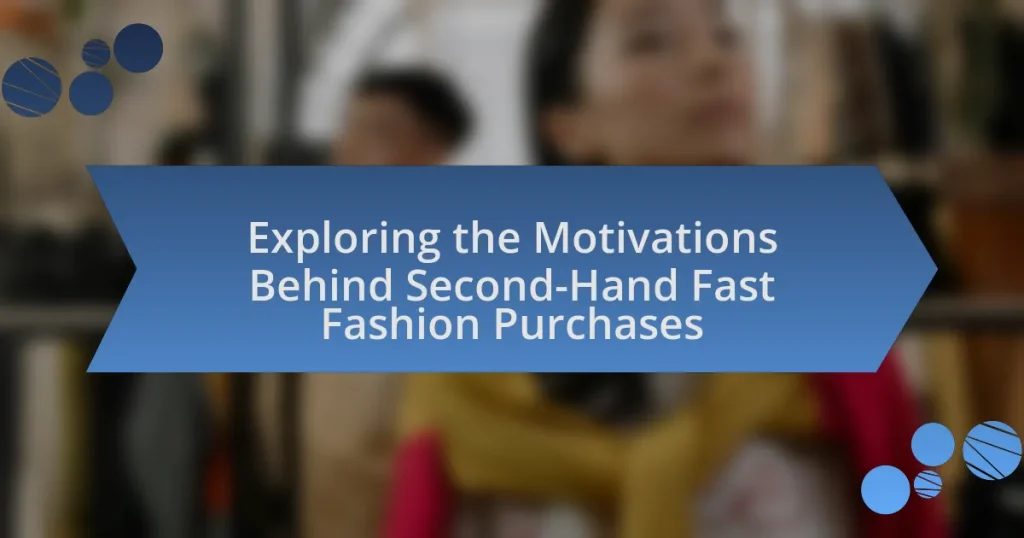The article explores the motivations behind second-hand fast fashion purchases, highlighting key factors such as economic savings, environmental concerns, and the desire for unique fashion items. It examines how demographic factors, including age, income, and gender, influence consumer behavior, with younger generations showing a stronger inclination towards sustainability. The role of social influences, cognitive biases, and marketing strategies in shaping purchasing decisions is also discussed. Additionally, the article addresses the implications of increased second-hand shopping on the fashion industry, including its environmental impacts and the challenges faced by traditional retail models.

What are the motivations behind second-hand fast fashion purchases?
The motivations behind second-hand fast fashion purchases primarily include economic savings, environmental concerns, and the desire for unique fashion items. Consumers often seek affordable alternatives to new clothing, as second-hand items typically cost less, allowing them to stretch their budgets further. Additionally, many buyers are motivated by sustainability, recognizing the negative environmental impact of fast fashion and opting for second-hand options to reduce waste. Furthermore, the appeal of unique or vintage pieces drives individuals to purchase second-hand items, as these can offer distinct styles not found in mainstream retail. Research indicates that 70% of consumers are influenced by sustainability when making fashion purchases, highlighting the growing trend towards second-hand shopping as a conscious choice.
Why do consumers choose second-hand fast fashion over new items?
Consumers choose second-hand fast fashion over new items primarily due to cost savings and environmental concerns. The affordability of second-hand items allows consumers to access trendy clothing at a fraction of the price of new items, making it an attractive option for budget-conscious shoppers. Additionally, the growing awareness of the environmental impact of fast fashion drives consumers to seek sustainable alternatives, with second-hand purchases reducing waste and promoting recycling. According to a 2021 report by ThredUp, the second-hand market is projected to reach $64 billion by 2024, indicating a significant shift in consumer behavior towards more sustainable fashion choices.
What role does sustainability play in these purchasing decisions?
Sustainability significantly influences purchasing decisions in the context of second-hand fast fashion. Consumers increasingly prioritize eco-friendly practices, leading them to choose second-hand options as a means to reduce waste and minimize their environmental impact. Research indicates that 66% of consumers are willing to pay more for sustainable brands, highlighting a growing trend towards environmentally conscious purchasing behavior. This shift is driven by awareness of the negative effects of fast fashion on the planet, prompting individuals to seek alternatives that align with their values of sustainability and ethical consumption.
How does the perception of value influence second-hand purchases?
The perception of value significantly influences second-hand purchases by shaping consumer attitudes towards price, quality, and sustainability. When consumers perceive second-hand items as offering high value—whether through affordability, unique style, or environmental benefits—they are more likely to make a purchase. Research indicates that 70% of consumers consider sustainability a key factor in their buying decisions, which enhances the perceived value of second-hand goods. Additionally, the uniqueness of second-hand items often adds to their allure, as shoppers seek distinctive pieces that reflect personal style, further reinforcing the value perception.
What demographic factors affect motivations for buying second-hand fast fashion?
Demographic factors such as age, income level, education, and gender significantly affect motivations for buying second-hand fast fashion. Younger consumers, particularly Millennials and Gen Z, are more inclined to purchase second-hand items due to environmental concerns and a desire for unique fashion, as evidenced by a 2021 report from ThredUp, which found that 70% of Gen Z shoppers prefer sustainable brands. Income level also plays a role; individuals with lower disposable income may seek second-hand options for affordability, while higher-income consumers might buy second-hand for sustainability or vintage appeal. Education influences awareness of environmental issues, with more educated individuals often prioritizing eco-friendly choices. Gender differences are evident as well, with women generally showing a higher propensity for second-hand shopping, driven by both sustainability and fashion trends.
How do age and gender influence purchasing behavior in this market?
Age and gender significantly influence purchasing behavior in the second-hand fast fashion market. Younger consumers, particularly those aged 18-34, are more inclined to purchase second-hand items due to their environmental consciousness and desire for unique fashion pieces. In contrast, older consumers, typically over 35, may prioritize quality and brand reputation, leading to different purchasing motivations. Gender also plays a crucial role; women are more likely to engage in second-hand shopping, driven by trends and sustainability concerns, while men may focus on practicality and value. Research indicates that 70% of women in this demographic have purchased second-hand clothing, compared to 50% of men, highlighting the gender disparity in this market.
What socioeconomic factors contribute to the appeal of second-hand fast fashion?
The appeal of second-hand fast fashion is significantly influenced by socioeconomic factors such as affordability, sustainability concerns, and changing consumer values. Many consumers, particularly in lower-income brackets, find second-hand clothing to be a cost-effective alternative to new fast fashion, allowing them to access trendy items without the financial burden. Additionally, growing awareness of environmental issues has led to a shift in consumer behavior, with many individuals prioritizing sustainable practices and opting for second-hand options to reduce waste. Research indicates that approximately 70% of millennials are willing to pay more for sustainable products, highlighting the importance of ethical considerations in purchasing decisions. Furthermore, the rise of online resale platforms has made second-hand shopping more accessible, catering to a broader demographic and reinforcing the appeal of this market segment.
How do social influences impact second-hand fast fashion purchases?
Social influences significantly impact second-hand fast fashion purchases by shaping consumer perceptions and behaviors through social norms and peer pressure. Research indicates that individuals are more likely to buy second-hand items when they observe friends or influencers engaging in similar purchases, as this creates a sense of community and acceptance around sustainable fashion choices. A study published in the Journal of Consumer Research found that social media platforms amplify these influences, with 70% of respondents indicating that seeing others wear second-hand clothing positively affected their purchasing decisions. This demonstrates that social validation and visibility play crucial roles in motivating consumers to opt for second-hand fast fashion.
What role do peer groups and social media play in shaping consumer choices?
Peer groups and social media significantly influence consumer choices by creating social norms and facilitating information sharing. Peer groups often establish trends and preferences that individuals feel compelled to follow, as seen in studies indicating that 79% of consumers are influenced by friends’ recommendations when making purchases. Social media platforms amplify this effect by providing a space for users to showcase their purchases, leading to increased visibility and desirability of certain products. Research shows that 54% of social media users have made a purchase based on content they saw on these platforms, highlighting the direct impact of social media on consumer behavior.
How does the desire for uniqueness drive second-hand fashion purchases?
The desire for uniqueness significantly drives second-hand fashion purchases by motivating consumers to seek distinctive items that set them apart from mainstream trends. This pursuit of individuality is often fueled by the perception that second-hand clothing offers rare and one-of-a-kind pieces, which are less likely to be worn by others. Research indicates that 70% of consumers are motivated to shop second-hand to find unique items that reflect their personal style, as noted in a study by ThredUp, which highlights the growing trend of individuality in fashion choices. Thus, the desire for uniqueness not only influences purchasing behavior but also shapes the overall appeal of second-hand fashion as a means of self-expression.

What are the psychological factors influencing second-hand fast fashion purchases?
The psychological factors influencing second-hand fast fashion purchases include social identity, environmental consciousness, and the desire for uniqueness. Social identity plays a significant role as consumers often seek to align their purchases with their self-image and the values of their peer groups, which increasingly favor sustainability. Environmental consciousness drives individuals to choose second-hand options as a means to reduce waste and promote eco-friendly practices, reflecting a growing awareness of the negative impacts of fast fashion on the environment. Additionally, the desire for uniqueness motivates consumers to seek out second-hand items that are often one-of-a-kind, allowing them to express their individuality in a market saturated with mass-produced goods. These factors are supported by research indicating that consumers are increasingly motivated by ethical considerations and personal expression in their purchasing decisions.
How does the concept of nostalgia affect consumer behavior?
The concept of nostalgia significantly influences consumer behavior by evoking emotional connections to past experiences, which can drive purchasing decisions. When consumers encounter products that remind them of their childhood or significant life events, they often feel a sense of comfort and familiarity, leading to increased likelihood of purchase. Research indicates that nostalgic feelings can enhance brand attachment and loyalty, as seen in a study published in the Journal of Consumer Research, where nostalgia was shown to increase consumers’ willingness to pay for products that evoke positive memories. This emotional engagement can be particularly potent in the context of second-hand fast fashion, where items may carry unique histories and personal stories, further amplifying their appeal to consumers seeking meaningful connections through their purchases.
What emotional connections do consumers have with second-hand items?
Consumers often develop strong emotional connections with second-hand items due to nostalgia, sustainability, and uniqueness. Nostalgia arises when individuals encounter items reminiscent of their past, evoking memories and feelings associated with previous experiences. Sustainability plays a significant role, as consumers feel a sense of responsibility and in choosing second-hand items, contributing to environmental conservation by reducing waste. Additionally, the uniqueness of second-hand items fosters a sense of individuality, allowing consumers to express their personal style distinctively. Research indicates that 70% of consumers are motivated by the desire to reduce their environmental impact when purchasing second-hand goods, highlighting the emotional satisfaction derived from making eco-conscious choices.
How does the thrill of the hunt contribute to purchasing decisions?
The thrill of the hunt significantly influences purchasing decisions by enhancing the emotional engagement and satisfaction associated with finding unique items. This excitement stems from the search process, where consumers experience a sense of adventure and anticipation, leading to increased motivation to purchase. Research indicates that the psychological reward from successfully locating a desired product can trigger the release of dopamine, reinforcing the behavior of seeking out second-hand items. A study published in the Journal of Consumer Research by authors such as Hagtvedt and Brasel (2017) highlights that consumers often derive pleasure from the act of searching, which can outweigh the actual value of the items found. This emotional connection to the hunt encourages repeat purchases and loyalty to second-hand markets, as shoppers seek to replicate the thrill experienced during previous successful finds.
What cognitive biases may affect second-hand fast fashion purchases?
Cognitive biases that may affect second-hand fast fashion purchases include the bandwagon effect, loss aversion, and the endowment effect. The bandwagon effect leads consumers to purchase second-hand items because they perceive that others are doing so, creating a social validation for their choices. Loss aversion causes individuals to prefer avoiding losses over acquiring equivalent gains, making them more likely to buy second-hand items at lower prices to avoid the perceived loss of not taking advantage of a good deal. The endowment effect occurs when consumers assign more value to items they own, which can influence their willingness to pay for second-hand goods that they feel a connection to. These biases are supported by behavioral economics research, which shows that social influences and emotional attachments significantly impact consumer decision-making.
How does the scarcity principle influence buying behavior?
The scarcity principle significantly influences buying behavior by creating a sense of urgency and increasing perceived value. When consumers perceive that a product is limited in availability, they are more likely to make impulsive purchasing decisions to avoid missing out. Research by Cialdini (2009) indicates that scarcity can enhance desirability, as people often associate limited supply with higher quality. This psychological trigger is particularly evident in second-hand fast fashion, where unique items may be available in small quantities, prompting quicker purchases from consumers who fear losing the opportunity to acquire them.
What impact does the framing effect have on consumer perceptions of value?
The framing effect significantly influences consumer perceptions of value by altering how information is presented, which can lead to different interpretations of the same product. For instance, when a second-hand fast fashion item is framed as “90% new” rather than “10% used,” consumers are more likely to perceive it as a better value. Research by Tversky and Kahneman (1981) demonstrates that the way choices are framed can affect decision-making, indicating that positive framing enhances perceived value. This suggests that marketers can strategically use framing to enhance consumer attraction to second-hand fast fashion, ultimately impacting purchasing behavior.
How do marketing strategies shape motivations for second-hand fast fashion?
Marketing strategies significantly shape motivations for second-hand fast fashion by emphasizing sustainability, affordability, and unique style. These strategies often highlight the environmental benefits of purchasing second-hand items, appealing to consumers’ growing concern for ecological issues; for instance, a study by McKinsey & Company found that 67% of consumers consider sustainability when making a purchase. Additionally, marketing campaigns frequently promote the cost-effectiveness of second-hand fashion, attracting budget-conscious shoppers. Furthermore, the portrayal of second-hand items as trendy and distinctive fosters a desire for individuality, as evidenced by platforms like Depop and Poshmark, which market their offerings as curated collections. Thus, effective marketing strategies align consumer motivations with the values of sustainability, affordability, and uniqueness in the second-hand fast fashion market.
What role do branding and storytelling play in attracting consumers?
Branding and storytelling are crucial in attracting consumers as they create emotional connections and convey a brand’s values. Effective branding establishes a unique identity that differentiates a product in a crowded market, while storytelling engages consumers by sharing relatable narratives that resonate with their experiences and aspirations. For instance, a study by the Harvard Business Review found that brands with strong narratives can increase customer loyalty by up to 30%, demonstrating that compelling stories enhance consumer engagement and drive purchasing decisions.
How do promotions and discounts affect purchasing decisions?
Promotions and discounts significantly influence purchasing decisions by creating a sense of urgency and perceived value among consumers. Research indicates that limited-time offers can lead to increased sales, as consumers are motivated to act quickly to take advantage of the savings. For instance, a study published in the Journal of Retailing found that discounts can enhance the attractiveness of products, leading to higher purchase intentions. Additionally, consumers often associate promotions with quality, believing that discounted items are a better deal, which further drives their decision-making process.

What are the implications of second-hand fast fashion purchases on the industry?
Second-hand fast fashion purchases significantly impact the industry by reducing demand for new clothing, thereby influencing production practices and sustainability efforts. As consumers increasingly opt for second-hand items, brands face pressure to adapt their business models, often leading to a shift towards more sustainable practices. For instance, a report by ThredUp indicates that the second-hand market is projected to reach $64 billion by 2024, highlighting a growing consumer preference that challenges traditional fast fashion’s linear consumption model. This shift encourages brands to consider circular economy principles, such as recycling and upcycling, to remain competitive and meet consumer expectations for sustainability.
How does the rise of second-hand fast fashion affect traditional retail models?
The rise of second-hand fast fashion significantly disrupts traditional retail models by shifting consumer preferences towards sustainability and affordability. As consumers increasingly seek eco-friendly options, the demand for second-hand clothing has surged, with the second-hand market projected to reach $64 billion by 2024, according to ThredUp’s 2021 Resale Report. This trend forces traditional retailers to adapt by incorporating sustainable practices, enhancing their online presence, and offering resale programs to compete effectively. Consequently, traditional retail models must evolve to address the changing landscape shaped by the growing popularity of second-hand fast fashion.
What challenges do new retailers face in adapting to this trend?
New retailers face significant challenges in adapting to the trend of second-hand fast fashion, primarily due to competition from established players and consumer perception. Established retailers often have brand loyalty and a robust supply chain, making it difficult for newcomers to gain market share. Additionally, new retailers must navigate the complexities of sourcing quality second-hand items while ensuring sustainability, which can be resource-intensive. According to a report by ThredUp, the second-hand market is projected to reach $64 billion by 2024, highlighting the intense competition and the need for new retailers to differentiate themselves effectively.
How are brands responding to the demand for second-hand items?
Brands are increasingly embracing the demand for second-hand items by launching their own resale platforms and collaborating with existing second-hand marketplaces. For instance, companies like Patagonia and Levi’s have introduced initiatives that encourage customers to buy, sell, or trade used clothing, reflecting a shift towards sustainability and circular fashion. According to a report by ThredUp, the second-hand market is projected to reach $64 billion by 2024, indicating a significant opportunity for brands to engage with eco-conscious consumers. This strategic response not only caters to consumer preferences but also aligns with broader environmental goals, as brands seek to reduce waste and promote sustainable practices.
What are the environmental impacts of increased second-hand fast fashion purchases?
Increased second-hand fast fashion purchases significantly reduce environmental impacts by extending the lifecycle of clothing and decreasing waste. This practice minimizes the demand for new garment production, which is responsible for substantial resource consumption, including water and energy, as well as greenhouse gas emissions. For instance, the production of a single cotton t-shirt requires approximately 2,700 liters of water, while second-hand purchases help conserve these vital resources. Additionally, the fashion industry contributes to around 10% of global carbon emissions; thus, buying second-hand can lower this figure by reducing the need for new manufacturing processes. Furthermore, diverting clothing from landfills mitigates the environmental hazards associated with textile waste, which can take decades to decompose and release harmful substances into the soil and water. Overall, increased second-hand fast fashion purchases promote sustainability by lessening the ecological footprint of the fashion industry.
How does second-hand shopping contribute to waste reduction?
Second-hand shopping significantly contributes to waste reduction by extending the lifecycle of clothing and other goods, thereby minimizing the amount of waste sent to landfills. When consumers purchase second-hand items, they reduce the demand for new products, which in turn decreases the resources and energy required for manufacturing, transportation, and disposal of new goods. According to a study by the Ellen MacArthur Foundation, extending the life of clothing by just nine months can reduce carbon, water, and waste footprints by around 20-30%. This demonstrates that second-hand shopping not only diverts items from waste streams but also promotes a more sustainable consumption model.
What are the potential downsides of the second-hand fast fashion market?
The potential downsides of the second-hand fast fashion market include the perpetuation of unsustainable consumption patterns and the potential for poor quality items to enter circulation. While buying second-hand can reduce waste, it may also encourage consumers to continue purchasing low-quality, trendy items that contribute to the fast fashion cycle. Research indicates that the second-hand market can sometimes lead to a lack of awareness about the environmental impact of clothing production, as consumers may feel less guilty about buying used items. Additionally, the influx of second-hand fast fashion can undermine local thrift shops and charities, which often rely on donations for funding.
What best practices can consumers adopt when purchasing second-hand fast fashion?
Consumers can adopt several best practices when purchasing second-hand fast fashion to ensure responsible and sustainable choices. First, they should thoroughly inspect items for quality and condition, as second-hand garments may have wear and tear that affects longevity. Research indicates that approximately 60% of clothing in landfills is recyclable, highlighting the importance of choosing durable pieces that can be reused or repurposed.
Second, consumers should prioritize purchasing from reputable thrift stores or online platforms that provide detailed descriptions and images, ensuring transparency about the item’s history and condition. This practice aligns with the growing trend of conscious consumerism, where informed choices lead to reduced environmental impact.
Additionally, consumers can educate themselves about brands known for ethical production practices, even in the second-hand market, to support sustainability. According to a report by the Ellen MacArthur Foundation, extending the life of clothing by just nine months can reduce carbon, water, and waste footprints by around 20-30%.
Lastly, consumers should consider the overall lifecycle of the garment, including how it can be reused or recycled after its second-hand use, promoting a circular economy. By following these best practices, consumers can make informed decisions that contribute to a more sustainable fashion industry.
How can consumers ensure quality and authenticity in their purchases?
Consumers can ensure quality and authenticity in their purchases by researching brands and sellers, verifying product details, and checking for certifications or reviews. Researching brands involves looking into their reputation, production practices, and customer feedback, which can reveal insights into the quality of their products. Verifying product details includes examining labels, materials, and any available documentation that confirms authenticity. Checking for certifications, such as organic or fair trade labels, and reading reviews from previous buyers can provide additional assurance of a product’s quality and authenticity.
What tips can help consumers make informed decisions in the second-hand market?
Consumers can make informed decisions in the second-hand market by thoroughly researching the item’s condition, verifying the seller’s credibility, and understanding the market value of similar items. Researching the item involves checking for any damages, wear, or authenticity, which can be done through detailed descriptions and images provided by the seller. Verifying the seller’s credibility can include reading reviews, checking ratings, and ensuring they have a return policy. Understanding the market value can help consumers avoid overpaying; for instance, platforms like eBay or Poshmark provide price comparisons for similar items. These practices enhance consumer confidence and satisfaction in their purchases.















